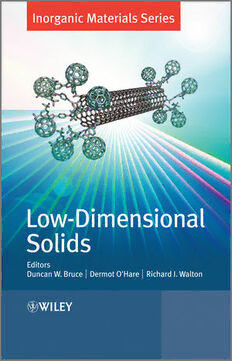Table Of ContentLow-Dimensional Solids
Low-Dimensional Solids Edited by Duncan W. Bruce, Dermot O’Hare and Richard I. Walton
© 2010 John Wiley & Sons, Ltd. ISBN: 978-0-470-99751-2
InorganicMaterialsSeries
Editors:
ProfessorDuncanW.Bruce
DepartmentofChemistry,UniversityofYork,UK
ProfessorDermotO’Hare
ChemistryResearchLaboratory,UniversityofOxford,UK
ProfessorRichardI.Walton
DepartmentofChemistry,UniversityofWarwick,UK
SeriesTitles
FunctionalOxides
MolecularMaterials
PorousMaterials
Low-DimensionalSolids
EnergyMaterials
Low-Dimensional Solids
Edited by
Duncan W. Bruce
UniversityofYork,UK
Dermot O’Hare
UniversityofOxford,UK
Richard I. Walton
UniversityofWarwick,UK
A John Wiley and Sons, Ltd, Publication
Thiseditionfirstpublished2010
(cid:2)2010JohnWiley&Sons,Ltd
Registeredoffice
JohnWiley&SonsLtd,TheAtrium,SouthernGate,Chichester,WestSussex,PO198SQ,
UnitedKingdom
Fordetailsofourglobaleditorialoffices,forcustomerservicesandforinformationabouthowtoapply
forpermissiontoreusethecopyrightmaterialinthisbookpleaseseeourwebsiteatwww.wiley.com.
Therightoftheauthortobeidentifiedastheauthorofthisworkhasbeenassertedinaccordancewith
theCopyright,DesignsandPatentsAct1988.
Allrightsreserved.Nopartofthispublicationmaybereproduced,storedinaretrievalsystem,or
transmitted,inanyformorbyanymeans,electronic,mechanical,photocopying,recordingor
otherwise,exceptaspermittedbytheUKCopyright,DesignsandPatentsAct1988,withouttheprior
permissionofthepublisher.
Wileyalsopublishesitsbooksinavarietyofelectronicformats.Somecontentthatappearsinprint
maynotbeavailableinelectronicbooks.
Designationsusedbycompaniestodistinguishtheirproductsareoftenclaimedastrademarks.All
brandnamesandproductnamesusedinthisbookaretradenames,servicemarks,trademarksor
registeredtrademarksoftheirrespectiveowners.Thepublisherisnotassociatedwithanyproductor
vendormentionedinthisbook.Thispublicationisdesignedtoprovideaccurateandauthoritative
informationinregardtothesubjectmattercovered.Itissoldontheunderstandingthatthepublisheris
notengagedinrenderingprofessionalservices.Ifprofessionaladviceorotherexpertassistanceis
required,theservicesofacompetentprofessionalshouldbesought.
Thepublisherandtheauthormakenorepresentationsorwarrantieswithrespecttotheaccuracyor
completenessofthecontentsofthisworkandspecificallydisclaimallwarranties,includingwithout
limitationanyimpliedwarrantiesoffitnessforaparticularpurpose.Thisworkissoldwiththe
understandingthatthepublisherisnotengagedinrenderingprofessionalservices.Theadviceand
strategiescontainedhereinmaynotbesuitableforeverysituation.Inviewofongoingresearch,
equipmentmodifications,changesingovernmentalregulations,andtheconstantflowofinformation
relatingtotheuseofexperimentalreagents,equipment,anddevices,thereaderisurgedtoreviewand
evaluatetheinformationprovidedinthepackageinsertorinstructionsforeachchemical,pieceof
equipment,reagent,ordevicefor,amongotherthings,anychangesintheinstructionsorindicationof
usageandforaddedwarningsandprecautions.ThefactthatanorganizationorWebsiteisreferredto
inthisworkasacitationand/orapotentialsourceoffurtherinformationdoesnotmeanthattheauthor
orthepublisherendorsestheinformationtheorganizationorWebsitemayprovideor
recommendationsitmaymake.Further,readersshouldbeawarethatInternetWebsiteslistedinthis
workmayhavechangedordisappearedbetweenwhenthisworkwaswrittenandwhenitisread.No
warrantymaybecreatedorextendedbyanypromotionalstatementsforthiswork.Neitherthe
publishernortheauthorshallbeliableforanydamagesarisingherefrom.
LibraryofCongressCataloging-in-PublicationData
Low-dimensionalsolids/editedbyDuncanW.Bruce,DermotO’Hare,RichardI.Walton.
p.cm.—(Inorganicmaterialsseries)
Includesbibliographicalreferencesandindex.
ISBN978-0-470-99751-2(cloth)
1. Nanotubes. 2. Nanowires. 3. Metallicoxides. 4. Inorganiccompounds.
5. Superconductingcomposites. I. Bruce,DuncanW. II. O’Hare,Dermot.
III. Walton,RichardI.
TA418.9.N35L692010
6200.5—dc22
2009051021
AcataloguerecordforthisbookisavailablefromtheBritishLibrary.
PrintISBN:978-0-470-99751-2(Cloth)
ePDFISBN:978-0-470-66139-0
oBookISBN:978-0-470-66140-6
Setin10.5/13ptSabonbyIntegraSoftwareServicesPvt.Ltd,Pondicherry,India.
PrintedandboundbyTJInternational,Padstow,Cornwall
Contents
InorganicMaterialsSeriesPreface ix
Preface xi
ListofContributors xiii
1 MetalOxideNanoparticles 1
AlanV.ChadwickandShellyL.P.Savin
1.1 Introduction 1
1.2 OxideTypes;PointDefectsandElectricalConductivity 4
1.3 PreparationofNanoionicMaterials 10
1.4 Characterisation 13
1.4.1 DeterminationofParticleSizeandDispersion 13
1.4.2 CharacterisationofMicrostructure 16
1.4.3 TransportMeasurements 20
1.5 ReviewoftheCurrentExperimentalDataandtheir
AgreementwithTheory 30
1.5.1 Microstructure 30
1.5.2 Transport 31
1.5.3 MechanicalProperties 42
1.5.4 MagneticProperties 44
1.6 Applications 46
1.6.1 GasSensors 46
1.6.2 Batteries 50
1.6.3 FuelCells 54
1.6.4 CatalysisandAdsorption 55
1.6.5 BiomedicalApplicationsofMagnetic
NanocrystallineOxides 60
1.7 OverviewandProspects 62
References 65
2 InorganicNanotubesandNanowires 77
C.N.R.Rao,S.R.C.VivekchandandA.Govindaraj
2.1 Introduction 77
2.2 InorganicNanotubes 78
2.2.1 Synthesis 79
vi CONTENTS
2.2.2 FunctionalisationandSolubilisation 114
2.2.3 PropertiesandApplications 115
2.3 Nanowires 116
2.3.1 Synthesis 116
2.3.2 Self-AssemblyandFunctionalisation 127
2.3.3 PropertiesandApplications 130
2.4 Outlook 145
References 146
3 BiomedicalApplicationsofLayeredDoubleHydroxides 163
Jin-HoChoy,Jae-MinOhandDae-HwanPark
3.1 Introduction 163
3.1.1 LayeredNanohybrids 163
3.1.2 LayeredNanomaterials 164
3.2 NanomaterialsforBiologicalApplications 167
3.2.1 LayeredNanoparticlesforBiomedical
Applications 167
3.2.2 CellularUptakePathway
ofDrug-InorganicNanohybrids 174
3.2.3 TargetingEffectofDrug-Inorganic
Nanohybrids 178
3.3 NanomaterialsforDNAMolecularCodeSystem 180
3.3.1 GeneticMolecularCodeinDNA 180
3.3.2 ChemicallyandBiologicallyStabilisedDNA
inLayeredNanoparticles 180
3.3.3 InvisibleDNAMolecularCodeSystem
forUbiquitousApplication 183
3.4 Conclusion 184
References 184
4 CarbonNanotubesandRelatedStructures 189
M.A´ngelesHerranz,JuanLuisDelgadoandNazarioMart´ın
4.1 Introduction 189
4.2 EndohedralFullerenes 191
4.2.1 EndohedralMetallofullerenes 191
4.2.2 SurgeryofFullerenes 197
4.3 CarbonNanotubes 200
4.3.1 CovalentFunctionalisation 201
4.3.2 NoncovalentFunctionalisation 205
4.3.3 EndohedralFunctionalisation 208
CONTENTS vii
4.4 OtherCarbonNanotubeForms 209
4.4.1 Cup-StackedCarbonNanotubes 209
4.4.2 CarbonNanohorns 210
4.4.3 CarbonNanobuds 211
4.4.4 CarbonNanotori 212
4.5 CarbonNano-Onions 213
4.6 Graphenes 216
4.7 SummaryandOutlook 219
Acknowledgements 219
References 220
5 MagnesiumDiborideMgB :ASimpleCompoundwith
2
ImportantPhysicalProperties 229
MichaelPissas
5.1 Introduction 229
5.1.1 ElectronicStructureofMgB 232
2
5.1.2 SubstitutionsinMgB Superconductor 235
2
5.2 PreparationofPureandAlloyedMgB 236
2
5.2.1 PreparationofPureandAlloyedPolycrystalline
MgB 236
2
5.2.2 SingleCrystalGrowthofPristineandAlloyed
MgB 245
2
5.3 PhysicalPropertiesofMgB 246
2
5.3.1 BoronIsotopeEffect 246
5.3.2 EvidenceforTwoEnergyGapsinMgB 248
2
5.3.3 DependenceoftheSuperconductingTransition
TemperatureonHydrostaticPressure 249
5.3.4 ResistivityMeasurementsinMgB 250
2
5.4 FluxLinePropertiesinSingleCrystalsofMgB ,
2
Mg Al B andMgB C 256
1(cid:2)x x 2 2(cid:2)x x
5.4.1 TypeIISuperconductors 256
5.4.2 FluxLinePropertiesofPristineMgB 259
2
5.4.3 AluminiumSubstitutedSingleCrystals 266
5.4.4 CarbonSubstitutedSingleCrystals 271
5.4.5 Two-BandSuperconductivityandPossible
ImplicationsontheVortexMatterPhase
Diagram 275
5.5 Conclusions 278
References 278
Index 287
Inorganic Materials
Series Preface
Back in 1992, two of us (DWB and DO’H) edited the first edition of
InorganicMaterialsinresponsetothegrowingemphasisandinterestin
materials chemistry. The second edition, which contained updated
chapters, appeared in 1996 and was reprinted in paperback. The aim
had always been to provide the reader with chapters that while not
necessarily comprehensive, nonetheless gave a first-rate and well-refer-
enced introduction to the subject for the first-time reader. As such, the
target audience was from first-year postgraduate student upwards.
Authors were carefully selected who were experts in their field and
actively researching their topic, so were able to provide an up-to-date
review of key aspects of a particular subject, whilst providing some
historical perspective. In these two editions, we believe our authors
achievedthisadmirably.
In the intervening years, materials chemistry has grown hugely and
nowfindsitselfcentraltomanyofthemajorchallengesthatfaceglobal
society. We felt, therefore, that there was a need for more extensive
coverage of the area and so Richard Walton joined the team and, with
Wiley, we set about a new and larger project. The Inorganic Materials
Series is the result and our aim is to provide chapters with a similar
pedagogical flavour but now with much wider subject coverage.
As such, the work will be contained in several themed volumes. Many
of the early volumes concentrate on materials derived from continuous
inorganic solids, but later volumes will also emphasise molecular and
softmattersystemsasweaimforamuchmorecomprehensivecoverage
oftheareathanwaspossiblewithInorganicMaterials.
We approached a completely new set of authors for the new project
withthesamephilosophyinchoosingactivelyresearchingexperts,but
alsowiththeaimofprovidinganinternationalperspective,sotoreflect
the diversity and interdisciplinarity of the now very broad area of
inorganic materials chemistry. We are delighted with the calibre of
authors who have agreed to write for us and we thank them all for
x INORGANIC MATERIALS SERIES PREFACE
theireffortsandcooperation.Webelievetheyhavedoneasplendidjob
and that their work will make these volumes a valuable reference and
teachingresource.
DWB,York
DO’H,Oxford
RIW,Warwick
July2010
Preface
ThelateProfessorJeanRouxeloncewrotethat‘solidsbringtomindthe
ideaofvolume,anditmaythereforeseemparadoxicaltodiscusssolidsof
lowdimensionality’.Nonetheless,theconcepthasremainedusefulandis
still widely used by both chemists and physicists but perhaps not to
describethesamething!
To a chemist a low-dimensional solid may refer to a structure or
compound in which there is a high degree of anisotropy in the spatial
distribution of the chemical bonds, which may lead to nanoparticulate
(0D),fibrous(1D),orlamellar(2D)morphologies.Ontheotherhanda
physicist may take advantage of the anisotropy of a certain physical
property such as electrical conductivity, optical response or magnetisa-
tion.Infactthephysicalpropertiesoflow-dimensionalsolidscannotbe
fully described by simply transposing in 2 or 1 dimension the physical
laws that hold for 3D space. Low-dimensional solids can exhibit new
phenomena, for example the well-known case of charge density waves
thatwereobservedinthelayered,transition-metaldichalogenides.
In this book we would like to introduce you to new, relevant, con-
temporarytopics,whichdealwiththesynthesisandpropertiesof low-
dimensional solids. The five chapters describe structures, applications
orphenomenanotknownwhenInorganicMaterialswasproduced.Our
line-up of distinguished international authors have written on topics
ranging from the chemistry and physics of inorganic nanotubes and
sheets,quantumeffectsinnanoparticles,novellayeredsuperconductors
toinorganic-DNAdeliverysystems.
We are delighted by their efforts and trust you find what they have
writtenbothfascinatingandexciting.
DWB,York
DO’H,Oxford
RIW,Warwick
July2010

